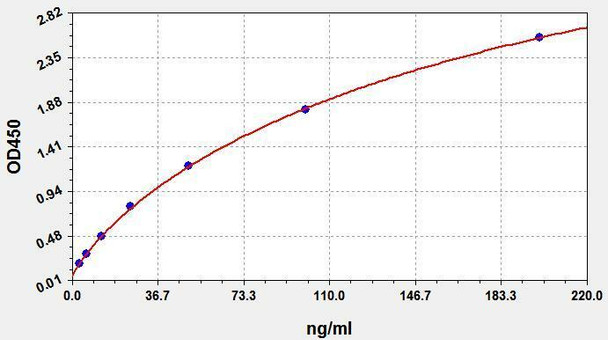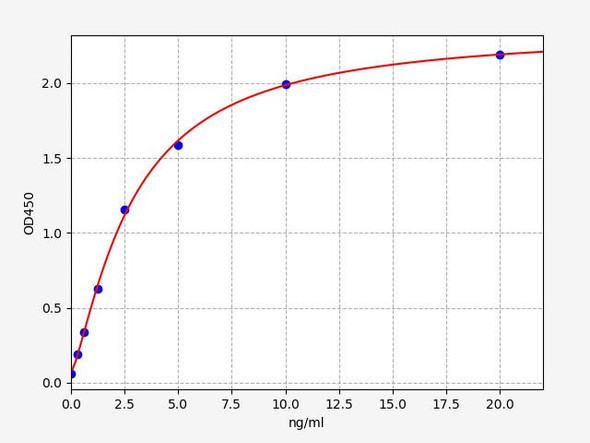Description
Mouse Ovalbumin Specific IgG/OVA sIgG ELISA Kit
The Mouse Ovalbumin-Specific IgG (OVA sIgG) ELISA Kit is a reliable tool for accurately measuring levels of Ovalbumin-specific IgG in mouse serum, plasma, and cell culture supernatants. This kit offers high sensitivity and specificity, ensuring precise and consistent results for a variety of research applications.Ovalbumin is a key protein commonly used in immunological research and vaccine development. Monitoring levels of Ovalbumin-specific IgG antibodies can provide valuable insights into immune responses and help researchers understand the effectiveness of immunization strategies.
Whether studying immune responses, vaccine efficacy, or antibody production, the Mouse Ovalbumin-Specific IgG ELISA Kit is an essential tool for researchers looking to advance their understanding of immunology and antibody-mediated immune responses.
| Product Name: | Mouse Ovalbumin Specific IgG / OVA sIgG ELISA Kit |
| Product Code: | MOFI01018 |
| Size: | 96 Assays |
| Alias: | OVA sIgG |
| Detection Method: | Indirect ELISA - HRP |
| Application: | This immunoassay kit allows for the in vitro quantitative determination of Mouse OVA sIgG concentrations in serum plasma and other biological fluids. |
| Sensitivity: | 1.875ng/ml |
| Range: | 3.125-200ng/ml |
| Storage: | 4°C for 6 months |
| Note: | For Research Use Only |
| Recovery: | Matrices listed below were spiked with certain level of Mouse OVA sIgG and the recovery rates were calculated by comparing the measured value to the expected amount of Mouse OVA sIgG in samples.
| ||||||||||||||||
| Linearity: | The linearity of the kit was assayed by testing samples spiked with appropriate concentration of Mouse OVA sIgG and their serial dilutions. The results were demonstrated by the percentage of calculated concentration to the expected. | ||||||||||||||||
| |||||||||||||||||
| Intra Assay: | CV <8% | ||||||||||||||||
| Inter Assay: | CV <10% |
| Component | Quantity | Storage |
| ELISA Microplate(Dismountable) | 8×12 strips | 4°C for 6 months |
| Lyophilized Standard | 2 | 4°C/-20°C |
| Sample/Standard Dilution Buffer | 20ml | 4°C |
| HRP-labeled Antibody (Concentrated) | 120ul | 4°C (Protect from light) |
| Antibody Dilution Buffer | 10ml | 4°C |
| TMB Substrate | 10ml | 4°C (Protect from light) |
| Stop Solution | 10ml | 4°C |
| Wash Buffer(25X) | 30ml | 4°C |
| Plate Sealer | 5 | - |
Other materials and equipment required:
- Microplate reader with 450 nm wavelength filter
- Multichannel Pipette, Pipette, microcentrifuge tubes and disposable pipette tips
- Incubator
- Deionized or distilled water
- Absorbent paper
- Buffer resevoir
*Note: Protocols are specific to each batch/lot. For the correct instructions please follow the protocol included in your kit.
| Step | Procedure |
| 1. | Set standard, test sample (diluted at least 50% with Sample Dilution Buffer) and control (blank) wells on the pre-coated plate and record their positions. It is recommended to measure each standard and sample in duplicate. Wash plate 2 times before adding standard, sample and control (blank) wells! |
| 2. | Aliquot 100µL of standard solutions into the standard wells. |
| 3. | Add 100µL of properly diluted Sample into the sample wells. |
| 4. | Seal the plate with a cover and incubate at 37 °C for 90 mins. |
| 5. | Wash: Repeat the aspiration/wash process for 3 times. |
| 6. | HRP-labelled antibody: Add 100µL of HRP-labelled antibody working solution into the bottom of each well (standard, test sample & zero wells) without touching the side walls. |
| 7. | Seal the plate with a cover and incubate at 37°C for 30 mins. |
| 8. | Wash: Remove the cover, and wash plate 5 times with Wash buffer. |
| 9. | TMB Substrate: Add 90 µL of TMB substrate into each well, cover the plate and incubate at 37°C in dark for 10-20 mins. (Note: This incubation time is for reference only, the optimal time should be determined by the end-user.) As soon as a blue colour develops in the first 3-4 wells (with most concentrated standards) and the other wells show no obvious colour, terminate the reaction. |
| 10. | Add 50µL of Stop solution into each well and mix thoroughly. The colour changes into yellow immediately. |
| 11. | Read the O.D. absorbance at 450 nm in a microplate reader immediately after adding the stop solution. |
When carrying out an ELISA assay it is important to prepare your samples in order to achieve the best possible results. Below we have a list of procedures for the preparation of samples for different sample types.
| Sample Type | Protocol |
| Serum: | If using serum separator tubes, allow samples to clot for 30 minutes at room temperature. Centrifuge for 10 minutes at 1,000x g. Collect the serum fraction and assay promptly or aliquot and store the samples at -80°C. Avoid multiple freeze-thaw cycles. If serum separator tubes are not being used, allow samples to clot overnight at 2-8°C. Centrifuge for 10 minutes at 1,000x g. Remove serum and assay promptly or aliquot and store the samples at -80°C. Avoid multiple freeze-thaw cycles. |
| Plasma: | Collect plasma using EDTA or heparin as an anticoagulant. Centrifuge samples at 4°C for 15 mins at 1000 × g within 30 mins of collection. Collect the plasma fraction and assay promptly or aliquot and store the samples at -80°C. Avoid multiple freeze-thaw cycles. Note: Over haemolysed samples are not suitable for use with this kit. |
| Urine & Cerebrospinal Fluid: | Collect the urine (mid-stream) in a sterile container, centrifuge for 20 mins at 2000-3000 rpm. Remove supernatant and assay immediately. If any precipitation is detected, repeat the centrifugation step. A similar protocol can be used for cerebrospinal fluid. |
| Cell culture supernatant: | Collect the cell culture media by pipette, followed by centrifugation at 4°C for 20 mins at 1500 rpm. Collect the clear supernatant and assay immediately. |
| Cell lysates: | Solubilize cells in lysis buffer and allow to sit on ice for 30 minutes. Centrifuge tubes at 14,000 x g for 5 minutes to remove insoluble material. Aliquot the supernatant into a new tube and discard the remaining whole cell extract. Quantify total protein concentration using a total protein assay. Assay immediately or aliquot and store at ≤ -20°C. |
| Tissue homogenates: | The preparation of tissue homogenates will vary depending upon tissue type. Rinse tissue with 1X PBS to remove excess blood & homogenize in 20ml of 1X PBS (including protease inhibitors) and store overnight at ≤ -20°C. Two freeze-thaw cycles are required to break the cell membranes. To further disrupt the cell membranes you can sonicate the samples. Centrifuge homogenates for 5 mins at 5000xg. Remove the supernatant and assay immediately or aliquot and store at -20°C or -80°C. |
| Tissue lysates: | Rinse tissue with PBS, cut into 1-2 mm pieces, and homogenize with a tissue homogenizer in PBS. Add an equal volume of RIPA buffer containing protease inhibitors and lyse tissues at room temperature for 30 minutes with gentle agitation. Centrifuge to remove debris. Quantify total protein concentration using a total protein assay. Assay immediately or aliquot and store at ≤ -20 °C. |
| Breast Milk: | Collect milk samples and centrifuge at 10,000 x g for 60 min at 4°C. Aliquot the supernatant and assay. For long term use, store samples at -80°C. Minimize freeze/thaw cycles. |
| Angkawinitwong et al. | A Novel Transdermal Protein Delivery Strategy via Electrohydrodynamic Coating of PLGA Microparticles onto Microneedles | ACS Applied Materials & Interfaces 2020 | PMID: 32066234 |









